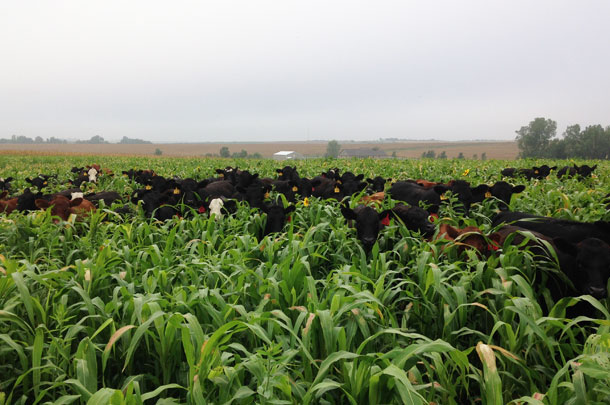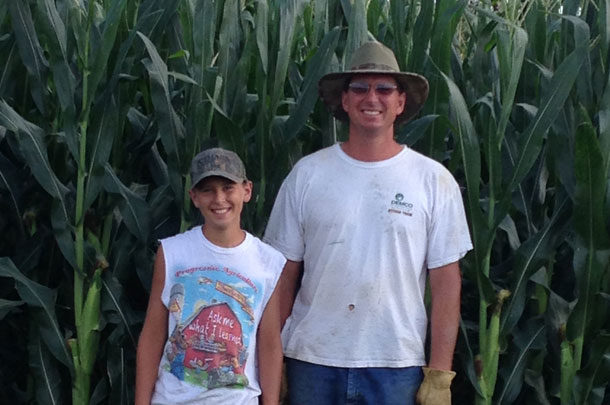With his oldest daughter approaching the age of high school sports, Buessing and his wife, Sandy, had to make some difficult decisions that would later contribute to their success. Because he was unable to attend his daughter’s extracurricular activities, care for the cattle, tend to the farm and work a day job, Buessing reverted to cover crops hoping the switch to holistic management would give him a little more flexibility.
“At the time, I was doing a little bit of cover cropping and I had a few head of cattle, but it really started to get more intense when she was getting ready to play sports,” Buessing says. “My wife asked me one day how I was going to do everything and make it to my daughter’s sporting events. She thought I was going to sell the cattle, but I figured out that if I planted more cover crops and grazed them in the winter as forage, the cattle could basically take care of themselves.”
From the time they bought their first farm in 1998, Buessing has used cereal rye and spring oats as a cover crop for forage. Over the years, he has added more varieties and tried different practices, but it wasn’t until he realized that he wanted more time to spend with family that cover crops became a bigger priority.
“We own about 440 acres, which isn’t a lot for a typical farm in our area,” Buessing says. “After experimenting and learning about cover crops for a few years, I figured that this could be a way for me to do it all – attend sporting events, quit my day job and keep my cattle business.”
Buessing points out that his original intent wasn’t to get rid of his day job. But as he began to think more and more in terms of integrated production, he found himself transitioning out of his day job and into farming full-time. He discovered that just by expanding his rotation, selling cover crops and using an intensive cover crop grazing system, he could maximize profits.

Continual benefits
Like many cover crop growers, Buessing says he has noticed improvements in his soil, better resistance to weeds and substantial bushel increases. When he first began his cover crop journey, he was ranging anywhere between a two- to five-bushel increase on his soybean crop when it followed a cereal rye cover after corn. More recently, however, he has noticed up to a 10-bushel increase after keeping a root in the soil at all times.
“During the first year you plant, you will see pictures of cover crops and you will get a little frustrated because your soil hasn’t started rebuilding itself, and the more it starts rebuilding, the better your cover crops and traditional crops will look,” he says.
“It’s a slow process, because it’s year by year. You can see benefits in one year, but it takes five to 10 years before you see some of those bigger benefits.”
Traditionally, Buessing grows corn, soybean, wheat and alfalfa. But within the last couple of years, he has started to include triticale, barley and chickling vetch into his production. In doing so, he has essentially improved his operation without using costly inputs.
Utilizing his resources
Because Buessing lives in an area where pasture is scarce, the cover crop blends have provided the feed needed to graze anywhere from 100 to 200 head of cattle. Typically, he grass finishes his steers and a few heifers that weren’t bred for the next calving season; a few 300-pounders and about 120 head are finished separately on corn.
The cattle that are finished on corn are in a confinement that allows him to use corn stalks or wheat straw to capture the urine and manure to fertilize his fields. This way he can utilize every resource available on his operation without adding extra costs.
Within the last couple of years, Buessing has also started to feed his cattle hay in the winter to help utilize calf prices and to fertilize specific locations on his property. He can place the hay according to where the land needs to be fertilized without having to use commercial fertilizer.
Buessing says he plans to continue learning and experimenting with cover crops. He has looked at other possibilities, such as pasturing pigs and poultry. He believes that cover crops are the way to go, especially for a small-scale farmer.
“For a farmer that doesn’t have a lot of acreage, cover crops provide a lot more entities to stack upon each other,” he says. “I have essentially been able to do a lot more with less and have seen the lasting benefits. I am always looking for new things I can do with this form of management.” FG
Cassidy Woolsey is a freelance writer based in Utah.
PHOTO 1: Bill Buessing and his son, Derek, standing in front of their conventional corn that had been no-tilled into previous cover crops.
PHOTO 2: The cattle gained about 2.78 pounds a day. Each acre of this 11-way blend produced about 180 pounds of beef. Photos provided by Bill Buessing.












